
Franklinton is a town in Franklin County, North Carolina, United States. The population was 2,456 at the 2020 census.
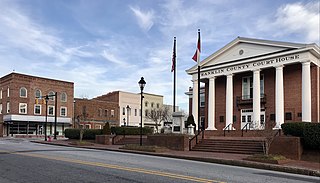
Louisburg is a town and the county seat of Franklin County, North Carolina, United States. As of the 2020 census, the town population was 3,064. The town is located approximately 29 miles northeast of the state capital, Raleigh, and located about 31 miles south of the Virginia border. It is also the home of Louisburg College, the oldest two-year coeducational college in the United States.

Louisburg College is a private Methodist-affiliated two-year college in Louisburg, North Carolina.
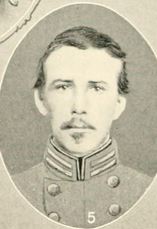
Charles Mather Cooke was a North Carolina politician who served as Speaker of the North Carolina House of Representatives (1881) and as North Carolina Secretary of State (1895–1897).
Albert Gamaliel Jones was a notable "house carpenter" from Warren County, North Carolina. He built "distinctive" Greek Revival plantation houses and college buildings.
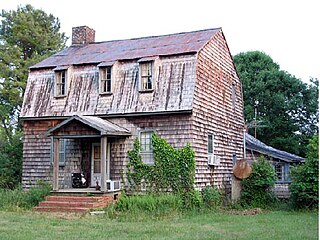
Shemuel Kearney House was a historic plantation house located near Franklinton, Franklin County, North Carolina, formerly at 2555 U.S. Highway 1 south of town. In 2009, the house was dismantled and moved to nearby Louisburg for restoration as the original property was recently zoned by Franklin County for commercial use. Therefore, the building had to be relocated. The Shemuel Kearney House was reconstructed next to another historic residence, the Cooke House, on Peach Orchard Road in 2015.

Green Hill House is a historic plantation house located near Louisburg, Franklin County, North Carolina. It was built prior to 1785, and is a 1+1⁄2-story, three-bay, Georgian style frame dwelling. It sits on a raised basement and has a rear shed extension. The house features large double-shoulder brick end chimneys. Green Hill (1741-1828) was active in the Methodist movement and his house was the scene in 1785 of the first annual conference of the newly organized Methodist Episcopal Church, attended by Bishop Francis Asbury and Bishop Thomas Coke.
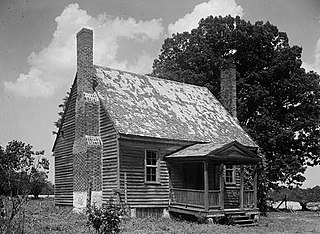
Cascine is a historic plantation complex and national historic district located near Louisburg, Franklin County, North Carolina. The district encompasses 12 contributing buildings, 4 contributing sites, and 3 contributing structures. The main house was built about 1850, and is a large two-story, Greek Revival style frame dwelling, in the manner of Jacob W. Holt, with Gothic Revival style influences. Also on the property is a small, one-story frame dwelling dated to about 1752. It was repaired and refurbished in the mid-20th century. Also on the property are the contributing brick kitchen, frame stable, granary, carriage house, family cemetery, slave cemetery, remains of slave quarters, tenant house, six log and frame tobacco barns, grist mill complex, and archaeological sites.
Dean Farm is a historic farm complex and national historic district located near Louisburg, Franklin County, North Carolina. The district encompasses two contributing buildings, one contributing site, and two contributing structures. The farmhouse was built about 1842, and is a two-story, three-bay, Federal / Greek Revival style frame dwelling. It has a gable roof and two large single-shoulder gable-end chimneys of large stone blocks. Also on the property are the contributing smokehouse, corn crib, harness room, and family cemetery.
Massenburg Plantation, also known as Woodleaf Plantation, is a historic plantation house located near Louisburg, Franklin County, North Carolina. The property encompasses 10 contributing buildings, 1 contributing site, and 1 contributing structure. The main house reached its present form in 1838, and is a simple two-story L-shaped dwelling, with a rear two-story wing. It is four bays wide and features a stone block chimney. The property is currently owned by Travis Massenburg. The property also includes the contributing plantation office, smokehouse, cotton gin, storage building, hen house, 1+1⁄2-story Perry House bungalow, and Overseer's House ruins.
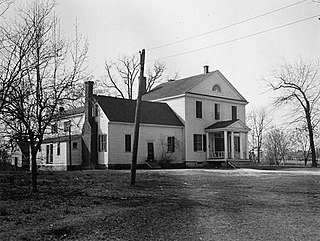
Person Place, also known as Prudence Person House, is a historic home located at Louisburg, Franklin County, North Carolina. It consists of a large two-story, three-bay, Federal style main block built about 1789, with a 1+1⁄2-story, three-bay Georgian wing. The front facade features a small three bay pedimented porch supported by four wooden Doric order columns. It also has two brick chimneys with concave shoulders.

Patty Person Taylor House is a historic home located near Louisburg, Franklin County, North Carolina. It was built about 1783, and is a two-story, five-bay, Georgian style frame dwelling. It has a gable roof and one-story rear extension. It has a center-hall plan one room deep, with notable Georgian woodwork. It was the home of the sister of Thomas Person (1733-1800), who died at the house in 1800.

Williamson House is a historic home located at Louisburg, Franklin County, North Carolina. It was built about 1855, and is a one-story, three bay by two bay, Greek Revival style frame cottage dwelling. It has a hipped roof and rests on a brick basement.

Fuller House is a historic home located at Louisburg, Franklin County, North Carolina. It was built in 1856, and is a two-story, three bay by two bay, Greek Revival style frame dwelling. It has a hipped roof and rests on a low foundation of stone blocks. The front facade features a full width front porch. It was the home of noted poet and novelist Edwin Wiley Fuller (1847–1876).
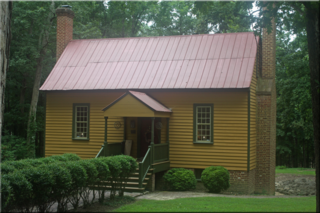
Portridge is a historic plantation house located near Louisburg, Franklin County, North Carolina at 225 May Road. While a number of sources say the home was built around 1780, it was actually constructed in circa 1764 according to its current owners. Portridge is a 1+1⁄2-story, three-bay, single pile Georgian style frame dwelling. It has a gable roof, three brick chimneys, and a one-room rear ell. Portridge was moved to its present location in 1984, and subsequently restored.
Rose Hill, later known as Timberlake House, is a historic plantation house located near Louisburg, Franklin County, North Carolina. The main block was built about 1803, and is a two-story, five-bay, transitional Georgian / Federal style frame dwelling. It has a gable roof and double-shouldered brick end chimneys. A rear ell was expanded about 1840, and about 1880 a one-story Queen Anne-style, full width verandah was added. About 1910, a Neoclassical portico was added over the verandah, as was a bathroom wing. Also on the property are the contributing slave quarter, kitchen, playhouse, and generator / wellhouse.

Thomas and Lois Wheless House is a historic home located at Louisburg, Franklin County, North Carolina. It was built in 1954–1955, and is a one-story, rectangular Modern Movement style dwelling of glass, wood, and stone. It has a low-pitched gable roof, rests on a concrete-slab foundation, and measures 30 feet wide and 72 feet deep.

Louisburg Historic District is a national historic district located at Louisburg, Franklin County, North Carolina. The district encompasses 206 contributing buildings, 1 contributing site, 6 contributing structures, and 1 contributing object in residential sections of Louisburg included in the original 1779 town plan. It also includes a section of Louisburg College located on the old Town Commons. Dwellings date between about 1800 and the 1920s and include notable examples of popular architectural styles including Federal / Georgian, Italianate / Greek Revival, Queen Anne, Colonial Revival, Late Victorian, and Bungalow / American Craftsman. Located in the district and separately listed are the Fuller House, Williamson House, and Main Building, Louisburg College. Other notable buildings include the Shine-King House, Milner-Perry-Boddie-Dennis House, Dr. J.B. Clifton House, The Edgerton-Pruitt House, The Furgurson-Hicks House, Nicholson-Bickett-Taylor House, The Hughes-Watson-Wheless House, Bailey-Yarborough House, The Barrow House, The Neal-Webb House, The Milner-Williams-Person Place, Former Rectory-St. Paul's Episcopal Church, Hicks-Perry-Bland-Holmes House, Malcomb McKinne House First Baptist Church (1927), Louisburg United Methodist Church (1900), and Louisburg Baptist Church (1901-1904).

Stewart-Hawley-Malloy House is a historic home located near Laurinburg, Scotland County, North Carolina. It was built about 1800, and is a transitional Georgian / Federal style frame dwelling. It consists of a two-story, five bay by two bay, main block with a one-story, two bay by four bay, wing. The main block has a full-width, one-story front porch and rear shed additions. It was built by North Carolina politician James Stewart (1775-1821) and the birthplace of Connecticut politician Joseph Roswell Hawley (1826-1905).

Merrimon-Wynne House, also known as the Merrimon House and Wynne Hall, is a historic home located at Raleigh, Wake County, North Carolina. The house was built about 1875, and is a two-story, four-bay, Italianate style frame dwelling with a cross-gabled roof and somewhat irregular massing. It is sheathed in weatherboard and features a Stick Style / Eastlake movement front porch with abundant ornamentation. The house was remodeled and complementary bay windows added about 1910. The house was built by Senator Augustus Summerfield Merrimon (1830-1892).



















